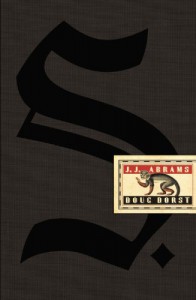me reading books
reviews - quotes - thoughts
- crossposting here and on goodreads -

I won’t give an overview of the plot, because I really think that the contents of this book should be experienced firsthand. I will only try to describe what I personally liked about this book (which is hard enough since this is not an ordinary novel).
So, be warned: rambling ahead! ;)
What I like best about this experiment in publishing is that the whole make up of this book is so beautiful and detailed. I love the postcards and letters and the napkin and the look and feel (and smell!) of the pages; I love how it is printed in so many different colours and that what is supposedly written with a pen actually looks like it has been written with a pen. And I still cannot get over the price of this work of art. It must have cost a lot to print and assemble the book and all its gimmicks; and still the book only cost 23€. Wow!
I also loved the way it gives insight into the world of literary studies. The way the two readers treat the text, analyse it and write down their theories reminded me a lot of the time I wrote my Master’s Thesis or any other time I wrote a paper. I wanted to communicate with Eric and Jen, tell them my own theories and compare notes with them.
And with that we’re right in the middle of plot territory. I really liked the two readers who left their notes in the margins of the main text. At times I was more interested in how their story was going to turn out than in the actual novel. I loved how these little notes showed their relationship progress and how through mere allusions you could actually make out two characters and even grow attached to them. In a way the same thing that happens between Eric and Jen happens to you as a reader, too. You start to like and care about these people even though all you have to back up that feeling is what they have written in the margins.
The other plot in this book is the actual novel „Ship of Theseus“ which is studied and discussed by Jen and Eric. That novel’s plot is creepy and weird and leaves a lot of questions unanswered. Which is a kind of narration I really like but it can leave the reader fairly unsatisfied. However, it seems like this is actually the point of „S.“. It ends and hands the solving of the puzzle over to the reader. You have to become like Jen and Eric and start your own research, maybe reread the book. For example, there is this wheel that came with the book, and it is mentioned by Jen and Eric but never used. So there must be a code I’m missing and a quick google search showed me that the people of the internet are already on it and trying to figure it out.
The book is not only an experiment in publishing and a study of the book as a medium; it also tries to make the story intermedial. It goes on in the heads of the readers and on their blogs and on message boards. You can immerse yourself in the world of „S.“. A really great idea IF we get something like a solution in the end. I really hope we won’t be left unsatisfied.
I would love to give five stars to „S.“ but the plot lacked in complexity (which is something that can still be changed if the story does go on in another medium). The reading experience was awesome and I’m looking forward to several rereads and internet research and maybe even solving the puzzle and answering the question that remain.
 3
3










